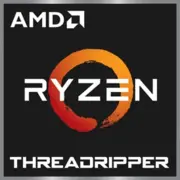AMD Ryzen Threadripper 2990WX

AMD Ryzen Threadripper 2990WX: Comprehensive Review of the Giant Processor (2025)
April 2025
1. Key Specifications: The Power of 32 Cores in Your PC
Architecture and Process Technology
The AMD Ryzen Threadripper 2990WX, released in 2018, continues to impress with its specifications. It is built on the Zen+ microarchitecture with a 12 nm process technology, which was groundbreaking for its time. The codename Colfax reflects its orientation towards professional workstations.
Key Parameters
- 32 Cores / 64 Threads: Maximum multithreading for rendering, modeling, and virtualization tasks.
- 64 MB L3 Cache: Reduces latency when working with large volumes of data.
- TDP 250W: High power consumption requiring serious cooling.
- Geekbench 6: Single-Core — 1166, Multi-Core — 7058.
Architecture Features
The Threadripper 2990WX utilizes a unique "Zeppelin" topology, where four die (CCD) are connected via Infinity Fabric. However, due to the architecture’s core distribution, only two CCDs have direct access to memory, which can sometimes lead to performance drops in latency-sensitive applications.
2. Compatible Motherboards: TR4 Socket and X399 Chipset
Platform Requirements
The processor is installed in the TR4 (Socket SP3r2), which is supported only by motherboards with the AMD X399 chipset. By 2025, such motherboards have become scarce, but some models are still available:
- ASUS ROG Zenith Extreme: High-quality VRM, Wi-Fi 6, NVMe RAID support.
- MSI MEG X399 Creation: 16-phase power delivery, 10 Gb Ethernet.
- Gigabyte AORUS Xtreme X399: Active chipset cooling, Thunderbolt 3.
Selection Features
- VRM Modules: Given the 250W TDP, a motherboard with a powerful power supply system (at least 12+ phases) is critical.
- PCIe 3.0 Ports: Supports up to 64 PCIe lanes but is not compatible with PCIe 4.0/5.0.
3. Supported Memory: DDR4 and Quad-Channel Configuration
The Threadripper 2990WX only works with DDR4, which appears outdated compared to DDR5 in 2025. However, the quad-channel configuration (up to 1 TB of RAM) compensates for this in professional tasks.
- Recommended Settings: DDR4-2933/3200 MHz with low timings (CL14-CL16).
- Minimum Capacity: 64 GB for rendering or virtual machine workloads.
4. Power Supplies: Don’t Skimp on Watts
With a TDP of 250W and peak power usage up to 300W, a PSU of at least 850W is required (1000+ W for a system with two GPUs).
- Recommendations: Corsair HX1000, Seasonic PRIME TX-850 (80+ Titanium).
- Cables: Mandatory use of 8-pin EPS connectors (two slots on the motherboard).
5. Pros and Cons: For Whom is the 2990WX Ideal, and for Whom is it a Fail?
Advantages
- Multithreaded Beast: Rendering in Blender (example: BMW scene — 2.5 minutes compared to 5+ minutes on 16-core CPUs).
- Showcase of 2018 Technology: ECC memory support, 64 PCIe lanes.
- Price: New units (if you can find them) are around $1200–$1500, which is cheaper than modern 32-core models.
Disadvantages
- Weak Single-Core Performance: In games (like Cyberpunk 2077 at 4K), it lags behind the Ryzen 7 7800X3D by 25–30%.
- Heat Output: Without liquid cooling (e.g., NZXT Kraken X72), temperatures under load reach 85–90°C.
- Outdated Platform: No PCIe 4.0, DDR5, or USB4 support.
6. Use Cases: Not for Twitch Streaming
Ideal Tasks
- 3D Rendering: Keyshot, Cinema 4D.
- Video Editing: 8K projects in DaVinci Resolve.
- Scientific Calculations: Molecular structure modeling.
- Virtualization: Running 10+ virtual machines simultaneously.
Poor Use Cases
- Gaming: Low FPS in CPU-bound games (e.g., Microsoft Flight Simulator).
- Office Tasks: Excess power for Excel or browser activities.
7. Competitors: Intel vs. AMD
Intel Core i9-10980XE (2019)
- 18 cores / 36 threads.
- Better in single-core (Geekbench 6: ~1300), but weaker in multithreading (Geekbench 6: ~5800).
- New price: $900–$1000 (rare).
AMD Ryzen Threadripper 3970X (2019)
- 32 cores / 64 threads on Zen 2 (7 nm).
- Multi-Core Geekbench 6: ~9800.
- New price: starting from $2000.
Conclusion: The 2990WX excels in multithreading over Intel but falls behind newer Threadrippers.
8. Assembly Tips: How to Avoid Mistakes
- Cooling: Only liquid cooling with a 360mm radiator or a top air cooler (Noctua NH-U14S TR4).
- Case: At least 6 fans for airflow (e.g., Lian Li PC-O11 Dynamic).
- SSD: Use NVMe drives (Samsung 990 Pro) to avoid bottlenecking on PCIe 3.0.
9. Conclusion: Who is the Threadripper 2990WX Suitable for in 2025?
This processor is a choice for professionals who need 32 cores at a reasonable price. If you are:
- A 3D artist, rendering for 8 hours a day;
- An engineer working with CFD simulations;
- An IT specialist deploying dozens of virtual servers,
then the 2990WX will be a budget-friendly solution. However, gamers and enthusiasts of “the latest technologies” should consider Ryzen 7000/8000 or Intel Core 14th Gen.
Price: New units (if available) — $1200–$1500.
This article is relevant as of April 2025. Check the availability of components with official suppliers.
Basic
CPU Specifications
Memory Specifications
GPU Specifications
Miscellaneous
Benchmarks
Compared to Other CPU
Share in social media
Or Link To Us
<a href="https://cputronic.com/cpu/amd-ryzen-threadripper-2990wx" target="_blank">AMD Ryzen Threadripper 2990WX</a>